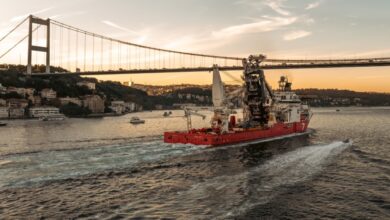MMS calls for further improvements in lifting safety
“Even though the majority of lifts are conducted safely, we still have a problem in that we have quite a few lifting incidents,” he cautioned.
From 1995 to 1 May 2008, about 470-480 crane lifting incidents were reported to the MMS. Data show a significant increase in incidents in 2006 and thereafter, although he pointed out that is likely due to the new incident reporting rule implemented in ’06. The rule has allowed MMS to receive better data, he said.
Observations from these statistics include:
• A significant number of incidents occurred while transferring cargo or people to/from an OSV.
• No fewer than 45 spills of oil or hydraulic fluid originated from cranes.
• There were no fewer than 30 minor fires.
• There were no fewer than 25 boom collapses. Causes were many, including corrosion of the crane pedestal, lifts being conducted shortly after a load test, use of temporary crane not properly secured.
There have also been a total of 150 injuries and 13 fatalities resulting from crane activities from 1995 to 1 May 2008. Already in 2008, two lifting fatalities have occurred in the Gulf.
For non-crane incidents on the OCS, there have been about 140 incidents in the same time frame, though Mr Levine pointed out that incidents were on the rise even before the new 2006 reporting rule.
There were about 100 injuries and 11 fatalities from non-crane incidents in this time.
From 1995-2006, a majority of non-crane lifting incidents involved material and pipe handling, and more than half involved the use of a hoist.
Looking at just injuries from 1995 to 1 May 2008, the numbers are stark. Approximately 250 out of 1,173 total injuries, or 21%, were the result of a lifting activity.
“That’s a pretty high number, and it’s the same story with fatalities” he said. About 24 of 106 fatalities were related to lifting.
Mr Levine noted that one of the most surprising statistics was found by looking at lifting incidents by water depth. From 2005-08, about 2/3 of lifting incidents occurred in water depths less than 1,000 ft and a third happened in water depths greater than 1,000 ft.
So what’s surprising about that? Only 2% of infrastructure (70 rigs and facilities) are located in water depths greater than 1,000 ft.
“It went against what I thought I’d see,” he said. Deepwater operations is supposedly where industry is keeping its best people, using the most expensive equipment and having more attention paid to equipment maintenance due to the value of the asset. Yet, “we’re seeing one-third of the incidents happening on 2% of infrastructures,” he noted.
Looking forward
The MMS has been considering many ways forward to improve lifting safety. On the regulatory front, the agency is mulling increasing the number of crane and non-crane inspections. It is also looking at evaluating civil penalties for select INCs (incident of non-compliance).
Mr Levine also encouraged the audience to continue participation in industry events such as the IADC Lifting Conference.
Finally, he suggested that IADC may consider forming a work group on lifting. Not only could this group evaluate incident data more carefully, it could formalize a link between industry and the API RP 2D crane schools.
Currently there’s no link between what is being seen and learned in the field and what is being taught in crane schools. Connecting safety initiatives and lessons learned in the field to the school curriculum could make a significant change, he said.
“To make something really happen, we need all the players to work together,” he urged.
Public MMS information are available online:
Safety alerts
http://www.gomr.mms.gov/homepg/offshore/safety/safealt/safemain.html
Panel investigations
http://www.gomr.mms.gov/homepg/offshore/safety/acc_repo/accindex.html
District investigations
http://www.gomr.mms.gov/homepg/offshore/safety/acc_repo/districtreports.html




